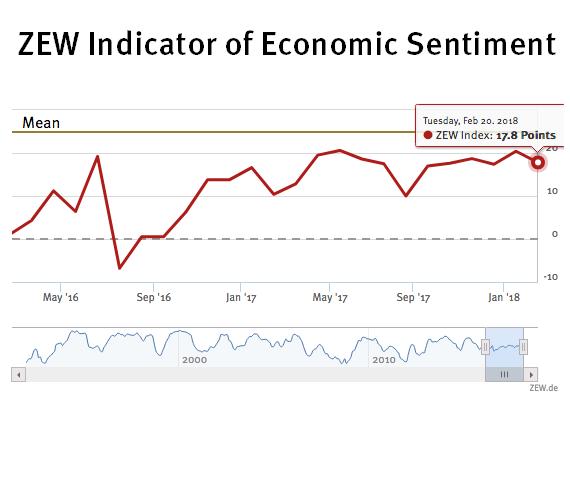Economic Sentiment Declines, but Remains at a High Level
ZEW Indicator of Economic SentimentThe ZEW Indicator of Economic Sentiment for Germany recorded a decrease of 2.6 points in February 2018 and currently stands at 17.8 points. The indicator thus still remains slightly below the long-term average of 23.7 points. The assessment of the current economic situation in Germany decreased by 2.9 points, with the corresponding indicator currently standing at 92.3 points.
“The latest survey results continue to show a positive outlook for the German economy. The assessment of the current economic situation is still on a very high level and the economy is expected to improve in the coming six months. Economic growth in Germany is substantially driven by the very good development of both the global economy and private consumption. Inflation expectations for Germany and the Eurozone have also started to increase,” comments ZEW President Professor Achim Wambach.
The financial market experts’ sentiment concerning the economic development of the Eurozone fell by 2.5 points, leaving the corresponding indicator at a level of 29.3 points. The indicator for the current economic situation in the Eurozone improved slightly in February. The indicator currently stands at 57.7 points, which corresponds to an increase of 1.3 points compared with the January result. The economic expectations for the Eurozone thus continue to be fairly positive. The positive economic outlook for Germany and the Eurozone is reflected in the fact that inflation expectations are rising. About two thirds of the survey participants expect the inflation rate in Germany and the entire euro area to increase in the next six months.
For more information please contact:
Dr. Michael Schröder, Phone: +49 (0)621/1235-368, E-mail michael.schroeder@zew.de
Lea Steinrücke, Phone +49 (0)621/1235-311, E-mail lea.steinruecke@zew.de
More information and studies on the ZEW Indicator of Economic Sentiment and the release dates 2018 (as PDF file, 28 KB) and the historical time series (as Excel file, 81 KB)
